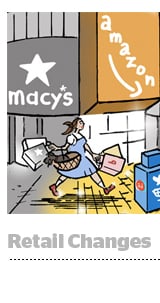 Q4 ecommerce sales were marked by a strong increase in transaction volume and a spike in mobile conversions, a smattering of retail reports shows.
Q4 ecommerce sales were marked by a strong increase in transaction volume and a spike in mobile conversions, a smattering of retail reports shows.
Among specific retailers, Amazon was the runaway winner (no surprise there) and brick-and-mortar players may emerge as losers, if an early glum report from Macy’s is any indicator.
Amazon reported dramatic growth both in the number of products sold on its platform and in the number of partners pushing those products. Its customers bought more than 23 million items on Cyber Monday, an increase of 40% year over year.
In the United States, use of the company’s Sponsored Products ad offering increased 200% year over year during the holiday season. And big brands like Payless Shoes and Pep Boys began selling on Amazon.
Macquarie retail analyst Ben Schachter estimates Amazon captured $22 billion in 2015, or nearly a quarter of omnichannel retail spend, as noted in The New York Times.
Macy’s was the first major retailer to post results for the holiday season. The company suffered a steeper-than-expected 4.7% revenue decline for November and December, and announced plans for layoffs and store closures to adjust to lowered sales expectations for 2016. Macy’s CEO Terry Lundgren said the cuts will help the company accelerate digital and mobile sales.
“We believe we can operate more effectively with an organization that is flatter and more agile so we can pursue growth and regain market share in our core Macy’s and Bloomingdale’s omnichannel businesses faster and with more intensity,” said Lundgren.
Mobile Surges
Overall holiday ecommerce revenue rose 12.1% from the 2014 holiday season, according to a report from Custora, an ecommerce marketing platform company.
The company reported that 30.4% of all online sales were placed on mobile devices.
A report from marketing firm HookLogic found that mobile traffic (though not necessarily transactions) accounted for nearly 60% of activity on its retail customers’ websites during the holiday season, peaking at 65% on Thanksgiving. Christmas Day trailed slightly with 64% mobile traffic.
Forrester Research retail analyst Sucharita Mulpuru-Kodali said growth in mobile commerce activity comes down to more user-friendly capabilities and more frequent engagements.
“People are spending more time than ever on mobile phones. They’re more comfortable purchasing on mobile phones and browsing on mobile phones,” she said. “And more people have larger mobile phones like the iPhone 6.”
The development of native payment capabilities on mobile devices eliminate the tactical inconvenience of entering credit card information, Frank said. “Convenience is a huge driver of consumer behavior.”
Email has also played a big role this season. Aggressive, promotional email strategies employed by marketers accounted for 20% of the holiday season’s online sales, according to Custora.
“Messages are being targeted with better precision. They are being sent to people who have a higher propensity to buy,” said Gartner Research analyst Andrew Frank. “Gradually marketers are learning how to weed out the misfires. And they’re figuring out how to target [consumers] and create more relevant offers based on data.”
Social buying, however, hardly made a splash.
According to Custora, social media outlets like Facebook, Twitter and Pinterest only drove 1.8% of ecommerce sales, a disappointing stat considering the resources social companies have invested in features like buy buttons.
“It’s still a little early in the evolution of these things,” Frank said. Marketers are facing difficulty with the fragmentations involved in implementing social commerce, he said.
“For now, it’s a factor of the relative novelty and lack of standards and clarity around social as a commerce medium.”












